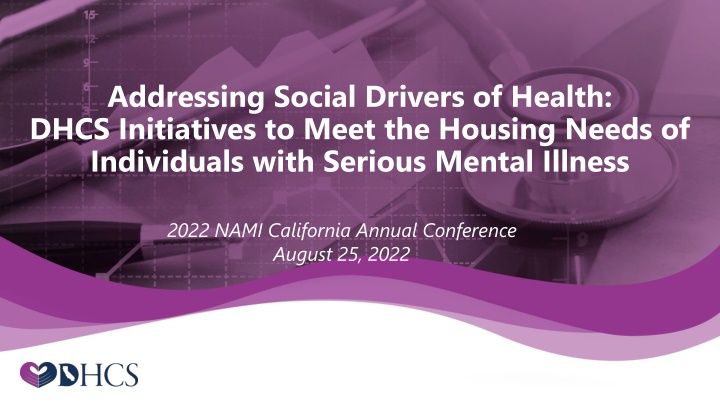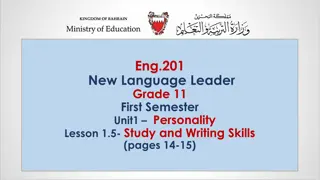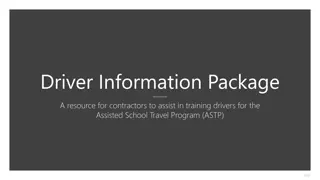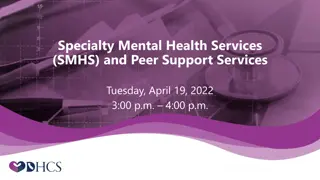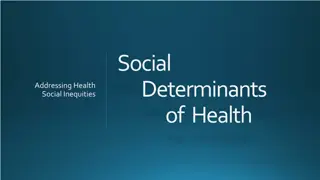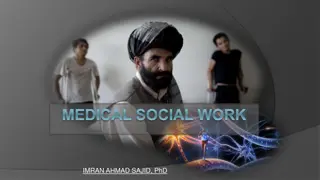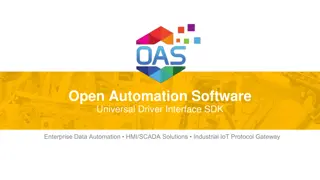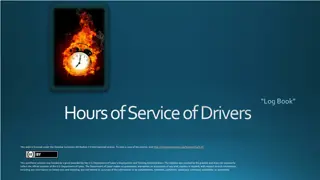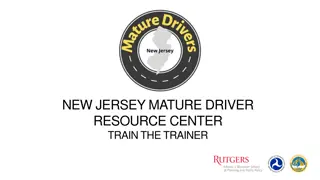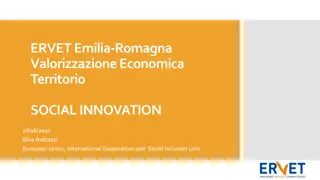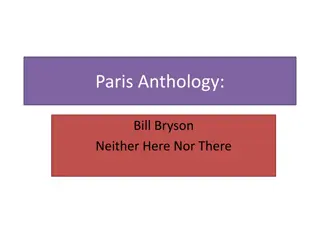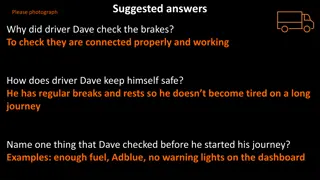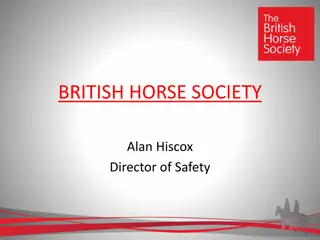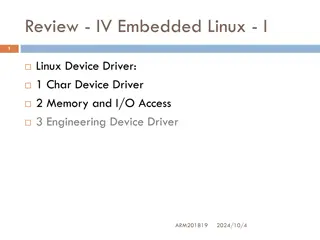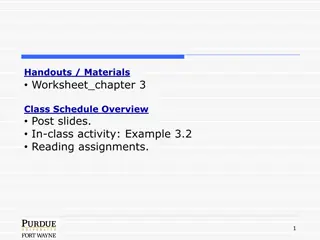DHCS Initiatives Addressing Social Drivers of Health
DHCS initiatives focus on meeting housing needs for individuals with serious mental illness, including CalAIM Housing and Homeless Incentive Program, Behavioral Health Bridge Housing, and more. Public Health Emergency unwinding due to COVID-19 PHE ending soon emphasizes the need to update beneficiary contact information to ensure continuity of coverage. The overview of CalAIM, Enhanced Care Management, and Community Supports highlights the long-term commitment to transform and strengthen Medi-Cal for a more equitable and person-centered approach.
Download Presentation

Please find below an Image/Link to download the presentation.
The content on the website is provided AS IS for your information and personal use only. It may not be sold, licensed, or shared on other websites without obtaining consent from the author.If you encounter any issues during the download, it is possible that the publisher has removed the file from their server.
You are allowed to download the files provided on this website for personal or commercial use, subject to the condition that they are used lawfully. All files are the property of their respective owners.
The content on the website is provided AS IS for your information and personal use only. It may not be sold, licensed, or shared on other websites without obtaining consent from the author.
E N D
Presentation Transcript
Addressing Social Drivers of Health: DHCS Initiatives to Meet the Housing Needs of Individuals with Serious Mental Illness 2022 NAMI California Annual Conference August 25, 2022
Agenda CalAIM Housing and Homeless Incentive Program Behavioral Health Bridge Housing Behavioral Health Continuum Infrastructure Program Q&A Closing Remarks 2
Public Health Emergency (PHE) Unwinding The COVID-19 PHE will end soon and millions of Medi-Cal beneficiaries may lose their coverage. Top Goal of DHCS: Minimize beneficiary burden and promote continuity of coverage for our beneficiaries. How you can help: Become a DHCS Coverage Ambassador Download the Outreach Toolkit on the DHCS Coverage Ambassador webpage Join the DHCS Coverage Ambassador mailing list to receive updated toolkits as they become available 3
DHCS PHE Unwind Communications Strategy Phase One: Encourage Beneficiaries to Update Contact Information Launch immediately Multi-channel communication campaign to encourage beneficiaries to update contact information with county offices. Flyers in provider/clinic offices, social media, call scripts, website banners. Phase Two: Watch for Renewal Packets in the mail. Remember to update your contact information! Launch 60 days prior to COVID-19 PHE termination. Remind beneficiaries to watch for renewal packets in the mail and update contact information with county office if they have not done so yet. 4
Overview of CalAIM, Enhanced Care Management (ECM) and Community Supports
California Advancing and Innovating Medi-Cal (CalAIM) CalAIM is a long-term commitment to transform and strengthen Medi-Cal, offering Californians a more equitable, coordinated, and person-centered approach to maximizing their health and life trajectory. The goals of CalAIM include: Implement a whole-person care approach and address social drivers of health. Improve quality outcomes, reduce health disparities, and drive delivery system transformation. Create a consistent, efficient, and seamless Medi-Cal system. 6
The Big Picture: Enhanced Care Management (ECM) and Community Supports On January 1, 2022, DHCS launched the first components of CalAIM: Enhanced Care Management and Community Supports; both include a specific focus on individuals experiencing SMI/SUD and/or homelessness. Community Supports Enhanced Care Management Enhanced Care Management (ECM) Services that Medi-Calmanaged care plans are strongly encouraged, but not required, to provide as medically appropriate and cost- effective alternatives to utilization of other services or settings such as hospital or skilled nursing facility admissions A Medi-Calmanaged carebenefit that will address clinical and non-clinical needs of high-need, high-cost individuals through the coordination ofservices and comprehensive care management 7
What is Enhanced Care Management (ECM)? ECM is a new Medi-Cal benefit to support comprehensive care management for enrollees with complex needs that must often engage several delivery systems to access care, including primary and specialty care, dental, mental health, substance use disorder (SUD), and long-term services and supports (LTSS). ECM is designed to address both the clinical and non-clinical needs of the highest-need enrollees through intensive coordination of health and health-related services, meeting enrollees wherever they are on the street, in a shelter, in their doctor's office, or at home ECM is part of broader CalAIM Population Health Management system design through which MCPs will offer care management interventions at different levels of intensity based on member need, with ECM as the highest intensity level For more details, see ECM Policy Guide (May 2022). 8
Launch & Expansion of ECM ECM Populations of Focus Go-Live Timing 1. Individuals and Families Experiencing Homelessness 2. Adult High Utilizers 3. Adults with Serious Mental Illness (SMI) / Substance Use Disorder (SUD) 4. Transitioning from Incarceration (some WPC counties) January 2022 (WPC / HH counties) July 2022 (all other counties) 5. At Risk for Institutionalization and Eligible for Long Term Care 6. Nursing Facility Residents Transitioning to the Community January 2023 7. Children / Youth Populations of Focus 4. Transitioning from Incarceration (statewide) July 2023 Beginning July 1, 2023 The Individuals Transitioning from Incarceration Population of Focus will go live in alignment with pre-release services, beginning July 1, 2023. DHCS has always intended to align the implementation dates of the justice- involved pre-release services initiative and the statewide launch of ECM justice-involved population of focus. For more information on Populations of Focus, see the ECM Policy Guide. 9
What are Community Supports? Community Supports are services that Medi-Cal managed care plans (MCPs) are strongly encouraged but not required to provide as substitutes for utilization of other services or settings such as hospital or skilled nursing facility admissions, discharge delays, or emergency department use. Community Supports are designed as cost-effective alternatives to traditional medical services or settings. Community Supports are designed to address social drivers of health (factors in people's lives that influence their health). For more details, see Community Supports Policy Guide (April 2022). 10
What are Community Supports? Pre-Approved DHCS Community Supports 1. 2. 3. 4. 5. 6. 7. 8. Housing Transition Navigation Services Housing Deposits Housing Tenancy and Sustaining Services Short-Term Post-Hospitalization Housing Recuperative Care (Medical Respite) Respite Services Day Habilitation Programs Nursing Facility Transition/Diversion to Assisted Living Facilities 9. Community Transition Services/Nursing Facility Transition to a Home 10. Personal Care and Homemaker Services 11. Environmental Accessibility Adaptations (Home Modifications) 12. Meals/Medically-Tailored Meals or Medically-Supportive Foods 13. Sobering Centers 14. Asthma Remediation For more details, see Community Supports Policy Guide (April 2022). 11
Who is Eligible for Community Supports? Each Community Support has specific eligibility criteria linked to each service Enrollees in Medi-Cal Managed Care may be eligible for Community Supports, which are voluntary to the enrollee Given Community Supports are optional to MCPs, there is a mix of how what Community Supports are available with each plan and each county For more details, see Community Supports Policy Guide (April 2022) and Community Supports Elections (January 2022). 12
Where are Community Supports Available Today? MCPs are phasing in Community Supports selections across counties in 2022 and 2023, with over 10 of the 14 Community Supports offered in 16 counties as of July 1, 2022 Riverside, Sacramento, and San Diego counties will offer all 14 Community Supports 97% of all California counties (56 out of 58) will offer at least 6 Community Supports Number of Community Supports by County Live as of July 1, 2022 MCPs can opt-in to offering new Community Supports every 6 months, in January or July 1 4 5 8 9 12 13 14 13
Overview of Providing Access and Transforming Health (PATH)
What is Providing Access and Transforming Health (PATH)? California has received targeted expenditure authority as part of its section 1115 demonstration renewal for the Providing Access and Transforming Health (PATH) program to take the State s system transformation to the next phase, refocusing its uses to achieve the CalAIM vision. DHCS has currently received authorization for $1.44 billion total computable funding for PATH to maintain, build, and scale the infrastructure and capacity necessary to ensure successful implementation of Enhanced Care Management (ECM) and Community Supports under CalAIM. PATH is intended to complement and enhance other CalAIM funding efforts and should not serve as a primary source of funding. PATH funding for all initiatives is time-limited and should not be viewed as a sustainable, ongoing source of funding. 15
Key PATH Program Initiatives PATH Initiative Name* High-Level Description Time limited support to sustain existing WPC pilot services that have transitioned to ECM and Community Supports and that MCPs have committed to cover, through the transition (no later than January 2024). Application process and funding began in Q1 2022. Funding to support collaborative planning as well as infrastructure and capacity needed to maintain and build pre-release enrollment and suspension processes and implement pre-release services to support implementation of the full suite of statewide CalAIM justice-involved (JI) initiatives in 2023. Application process and funding is ongoing. Support for collaborative planning and implementation groups among MCPs, providers, community-based organizations, county agencies, public hospitals, Medi-Cal Tribal and the Designees of Indian Health Programs, and others to promote readiness for ECM and Community Supports. Funding anticipated to begin in Fall 2022. Grant funding to enable the transition, expansion, and development of capacity and infrastructure for providers, community-based organizations, county agencies, public hospitals, Medi-Cal Tribal and the Designees of Indian Health Programs, and others to provide ECM and Community Supports. Application process is currently open and funding anticipated to being in Winter 2022. Technical assistance to providers, community-based organizations, county agencies, public hospitals, Medi-Cal Tribal and the Designees of Indian Health Programs, and others. Application process and funding anticipated to begin in January 2023. WPC Services and Transition to Managed Care Mitigation Initiative Justice Involved Capacity Building Collaborative Planning and Implementation Initiative Capacity and Infrastructure Transition, Expansion and Development (CITED) Initiative Technical Assistance Marketplace Initiative 16
Opportunities for PATH Funding to Support Entities Implementing ECM/Community Supports PATH can provide critical funding to select entities implementing or preparing to implement ECM and Community Supports. PATH Initiative Sample Funding Uses Launching a collaborative planning group with key entities in a county/region to support: Hiring a facilitator that convenes collaborative groups on a monthly basis Conducting focus groups ECM / Community Support needs and gaps within the community Identifying and resolving topical implementation issues that require additional technical assistance Supporting alignment between PATH funding and IPP funding Grant funding to providers, counties, community-based organizations and others to: Recruit, hire and train staff to support ECM / Community Supports delivery Modifying, purchasing, or developing necessary infrastructure / systems Establishing an evaluation/monitoring plan for ECM / Community Supports Aweb-based marketplace that will provide the following types of resources, for example: Hands-on trainings for ECM / Community Supports providers (or those that wish to become an ECM or Community Supports Provider) Guidance for data sharing processes between providers and health plans Strategic planning consultations for entities implementing, or that plan to implement ECM / Community Supports Customized project-specific support provided by vendors registered with the TA Marketplace Collaborative Planning and Implementation Initiative CITED Initiative Technical Assistance Marketplace Initiative 17
PATH and IPP are Aligned But Distinct Incentive Payment Program (IPP) PATH Goals Support development of ECM and Community Supports infrastructure and capacity Grow and strengthen provider networks Eligible entities include: MCPs that elect to participate in the IPP and meet requirements to qualify for incentive payments DHCS anticipates MCPs will maximize the investment and flow of incentive funding to ECM and Community Support providers Flow of funds Funding will flow directly from DHCS to MCPs upon achieving set milestones MCPs are encouraged to share funding with providers to strengthen networks Goals Support development of ECM and Community Supports infrastructure and capacity Support technical assistance needs and other gaps not addressed by IPP Eligible entities include: Counties, former WPC Lead Entities, providers (including ECM and Community Supports providers), CBOs,Medi-Cal Tribal and the Designees of Indian Health Programs and others MCPs are not permitted to receive PATH funding for infrastructure, capacity or services Flow of funds Entities will apply for funding which will flow directly from DHCS or the TPA to awarded applicants Note: PATH funding is subject to key guardrails (e.g., cannot duplicate or supplant, regular progress reporting, alignment with MCPs) 18
Overview of Housing and Homeless Incentive Program (HHIP)
What is the Housing and Homeless Incentive Program (HHIP)? In accordance with section 9817 of the American Rescue Plan Act (ARPA) of 2021, DHCS developed a Medi-Cal Home and Community-Based Services (HCBS) Spending Plan detailing a series of initiatives that will enhance, expand, and strengthen HCBS in California. The Housing and Homelessness Incentive Program (HHIP) is one of the HCBS Transitions initiatives, which aim to expand and enhance programs that facilitate individuals transitioning to community-based, independent living arrangements. HHIP Overview: HHIP is a voluntary incentive program that will enable Medi-Cal managed care plans (MCPs) to earn incentive funds for making progress in addressing homelessness and housing insecurity as social determinants of health. Total Incentive Funds: $1.288 billion one-time funds ($644 million in state funds [ARPA] + $644 million in matching federal funding) HHIP Program Design: DHCS is designing HHIP with input from stakeholders, including but not limited to, MCPs, cities, counties, local Continuums of Care, providers, nonprofits, county behavioral health, county social services, local housing departments, and community-based organizations. Funding Timeline: Funding available through March 31, 2024 CMS Approval: The California HCBS Spending Plan, including HHIP, was approved by CMS on January 4, 2022.1 20 1 https://www.dhcs.ca.gov/Documents/CMS-Conditional-Approval-1-4-2022.pdf
Program Vision, Goals & Strategic Approach Drawing on the HCBS Spending Plan and the DHCS Quality Strategy, DHCS established HHIP guided by a defined program vision, goals, and strategic approach. VISION: improve health outcomes and access to whole person care services by addressing housing insecurity and instability as a social determinant of health for the Medi-Cal population GOALS STRATEGIC APPROACH Develop partnerships between MCPs and social service agencies, counties, public health agencies, and public and community-based housing agencies to address homelessness Provide rapid rehousing for Medi-Cal families and youth, and interim housing for aging and disabled populations Expand access to housing services and street medicine programs Improve access to coordinated housing, health and other social services Reduce avoidable use of costly health care services Improve whole person health for Medi-Cal enrollees, including behavioral health treatment and resources Implement solutions that manage information to better identify populations of focus and Member needs Ensure MCPs have the necessary capacity and partnerships to connect their members to needed housing services 1 Reduce and prevent homelessness 2 21
Program Definition DHCS has provided a definition for individuals who are experiencing homelessness and are at risk of homelessness that aligns with the Community Supports Policy Guide and the Housing and Urban Development (HUD) definition as provided in Section 91.5 of Title 24 of the Code of Federal Regulations (CFR).1 Individuals who are at risk of or are currently experiencing homelessness. Experiencing homelessness is defined as: An individual or family who lacks adequate nighttime residence; An individual or family with a primary residence that is a public or private place not designed for or ordinarily used for habitation; An individual or family living in a shelter; An individual exiting an institution into homelessness; An individual or family who will imminently lose housing in next 30 days; Unaccompanied youth and homeless families and children and youth defined as homeless under other federal statutes; or Individuals fleeing domestic violence. 22 1 Definition aligns with the Community Supports Policy Guide and 24 CFR 91.5.
Current HHIP Program Timeline 2022 2023 2024 Q1 Q2 Q3 Q4 Q1 Q2 Q3 Q4 Q1 J F M A M J J A S O N D J F M A M J J A S O N D J F M LHP MCPs draft & submit LHP* LHP payment issued DHCS review LHPs* Measurement Period 4 months $ IP payment issued DHCS review IP MCP draft & submit IP $ MCPs draft & submit S1 S1 payment issued DHCS review S1 Measurement Period 1 8 months $ S2 payment issued MCPs draft & submit S2 DHCS review S2 Measurement Period 2 10 months $ *MCPs will have 5 weeks from July 11 August 12 to revise measures 1.1, 2.1, 3.3, 3.4, and 3.5 based on updated guidance from DHCS.
CalAIM Resources CalAIM: https://www.dhcs.ca.gov/CalAIM/Pages/calaim.aspx ECM and Community Supports: https://www.dhcs.ca.gov/Pages/ECMandILOS.aspx PATH: https://www.dhcs.ca.gov/CalAIM/Pages/CalAIM-PATH.aspx PATH TPA-Led Initiatives: https://ca-path.com/ PATH CITED Round 1 Application: https://ca-path.com/cited Justice-Involved Initiative: https://www.dhcs.ca.gov/CalAIM/Pages/Justice.aspx 25
Need for BH Bridge Housing In 2020, California had an estimated 161,548 individuals experiencing homelessness. 51,785 were individuals experiencing chronic homelessness 37,599 were severely mentally ill 35,821 reported chronic substance use Bridge housing for individuals with BH issues are needed immediately, especially for individuals with BH conditions also experiencing unsheltered homelessness
Need for BH Bridge Housing The 2021 Budget Act provided $5.8 billion in infrastructure funding though Homekey, the Behavioral Health Continuum Infrastructure Program (BHCIP), and the Community Care Expansion (CCE) program to create new units and treatment beds for individuals experiencing or at risk of homelessness Infrastructure will take time to construct and become operational
BH Bridge Housing The $1.5B Behavioral Health Bridge Housing (BHBH) proposal will fund clinically enhanced bridge housing settings for people experiencing homelessness who have serious behavioral health conditions (mental health and/or substance use disorders) Will provide community-based care and housing aimed at preventing institutionalization and incarceration One-time grant funding administered by DHCS Qualified entities would be counties and tribal entities
BH Bridge Housing No local match required Counties/tribes must leverage current clinical BH investments Time-limited operational supports while BHCIP and CCE facilities are established Housing costs Operational funding Clinical wrap-around services Funding expended within a five-year period
BH Bridge Housing Provide case management and other medical, behavioral or social services and supports onsite, such as those provided by Full Service Partnerships, which provide field capable wrap around services BHBH will not to pay for specialty mental health and SUD services provided by counties these are funded by Medi-Cal. Goal is to pay for housing and housing-related services that are not covered by Medi-Cal (including Community Supports )
BH Bridge Housing Serve individuals with serious BH conditions, with a special focus on the SMI/SED population Many existing facilities are willing and able to serve this population, but cannot do so without operating funding and enhanced supports, which this effort will provide
Clinically Enriched Services Clinically enriched services are an essential aspect of the proposal: treatment, case management, peer support, recovery services Services could exist at a current housing setting or be added, which can include: Provided permanently on-site Brought in from a treatment provider setting Through mobile units
Local Need Must be the right fit for the local BH housing needs to balance the current availability and what needs to be expanded Focus on the clinical BH need Will require a local planning process Will require collaboration at the local level with encampment housing
Behavioral Health Continuum Infrastructure Program (BHCIP)
BHCIP Guiding Principles and Priorities Invest in behavioral health and community care options that advance racial equity Seek geographic equity of behavioral health and community care options Address urgent gaps in the care continuum for people with behavioral health conditions, including seniors, adults with disabilities, and children and youth Increase options across the life span that serve as an alternative to incarceration, hospitalization, homelessness, and institutionalization
BHCIP Guiding Principles and Priorities Meet the needs of vulnerable populations with the greatest barriers to access, including people experiencing homelessness and justice involvement Ensure care can be provided in the least restrictive settings to support community integration, choice, and autonomy Leverage county and Medi-Cal investments to support ongoing sustainability Leverage the historic state investments in housing and homelessness
Assessing the Continuum of Behavioral Health Services in California Released in January 2022 to provide data and stakeholder perspectives for DHCS as it implements major behavioral health initiatives and expands the behavioral health infrastructure through BHCIP
Data from Needs Assessment 75% of stakeholders report an urgent need for psychiatric acute care and inpatient treatment beds for youth 32% of outpatient facilities do not treat children and youth 25% of counties report issues with finding providers who are willing to treat youth involved in the justice system 75% of counties lack residential beds specifically for youth 68% of counties lack providers with the training and experience to meet the needs of youth with SUDs
BHCIP Overview Passed in FY 2021-22 State budget $2.2B total Amends Welfare and Institutions Code Provides competitive grants for counties, tribal entities, non-profit and for-profit entities to build new or expand existing capacity in the continuum of public and private BH facilities Funding will be only for new or expanding infrastructure (brick and mortar) projects and not BH services
BHCIP Overview DHCS will release Request for Applications (RFAs) for BHCIP through multiple rounds Rounds will target various gaps in California s BH facility infrastructure Rounds will remain open until funds are awarded Different entities will be able to apply in each round for specific projects to address identified infrastructure gaps Stakeholder engagement will occur throughout the project
BHCIP Rounds 1 & 2 Round 1: Mobile Crisis Awarded to California county, city, and tribal entity behavioral health authorities to implement or expand mobile crisis infrastructure and limited direct services. Through Rounds 1A and 1B, DHCS awarded $157.7 million to 51 entities to fund 237 new or enhanced mobile crisis teams. Round 2: Planning Grants Support preparation activities to plan for the acquisition and expansion of BH infrastructure throughout the state. Through Rounds 2A and 2B, DHCS awarded a combined total of $7.4 million to 51 applicants, 19 of which are tribal entities.
BHCIP Round 3: Launch Ready and Community Care Expansion In January 2021, DHCS and Department of Social Services (DSS), released a coordinated application for the BHCIP Round 3: Launch Ready and Community Care Expansion Program (CCE) Capital Expansion funding opportunities Applicants were invited to apply for either funding opportunity, or both In June 2022, DHCS awarded $518.5M in grants to 46 projects
Round 4: Children and Youth Request for Applications was released on June 1, 2022 Applications are due for submission by August 31st: https://www.infrastructure.buildingcalhhs.com/grantees/cy/ This round authorizes $480.5 million in funding opportunities through competitive grants to qualified entities to construct, acquire and rehabilitate real estate assets for children and youth The target population for this round of funding are children and youth ages 25 and younger. Applicants must demonstrate that facility expansion will only be for this population
Round 4 Eligible Facility Types Community Mental Health Clinic Community Wellness/Prevention Centers Crisis Stabilization Unit (CSU) Outpatient Treatment for Substance Use Disorders (SUD) Partial Hospitalization Program (Mental Health and SUD) School-Linked Health Center Psychiatric Health Facility (PHF) Adolescent Residential Treatment Facilities for Youth with SUD Children s Crisis Residential Program (CCRPs) Community Treatment Facility (CTF) Perinatal Residential SUD Facilities Psychiatric Acute Care Hospital Short-term Residential Therapeutic Program (STRTP)
Match Applicants are required to provide matching funds. Match requirements are set according to applicant type Tribal entities = 5% match Counties, cities, and nonprofit providers = 10% match For-profit providers and/or private organizations = 25% match Match in the form of cash and real property-such as equity in land/existing structures-to the real cost previously incurred by project are allowable Services are not an allowable match
Rounds 5 and 6 Round 5 will focus on the Crisis Continuum. A listening session was held on August 4th. A program update will be released in late September 2022. The RFA will be released in the Fall of 2022. The focus of Round 6 has yet to be determined. More information on Rounds 5 and 6 will be updated on the website.
BHCIP Resources CalHHS: https://www.infrastructure.buildingcalhhs.com Email: BHCIP@dhcs.ca.gov 48
Q A 49
